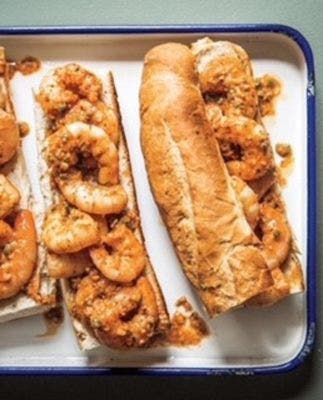Secrets of the Southern Table
Take a virtual road trip across the South! James Beard award-winning author and chef Virginia Willis chats with Fox News’s Lilian Huang Woo about her book Secrets of the Southern Table– an ode to its cuisines and people behind the food.
LISTEN HERE:
Makes about 9
My friend and colleague Dr. Marcie Cohen Ferris is a professor in the Department of American
Studies at the University of North Carolina. Her research and teaching interests include Southern
history and culture–particularly the foodways and material culture of the American South and the history of the Jewish South. In her excellent book The Edible South she writes, “In contemporary
worlds of popular and consumer culture, Southern food has become untethered from the complex
historical narrative responsible for this cuisine. Think of buckets of Southern fried chicken and cathead
biscuits like culinary spacecraft set adrift from the mother ship of southern history, culture,
and experience.” I wholeheartedly agree. Many people outside the South think all Southern food is
unhealthy and/or fried. The term cathead biscuit is an authentic one, indicating that it’s a biscuit as large as a cat’s head, and a phrase my grandfather once used. This extra-large biscuit would not have been the norm on the everyday table, but it has become the standard size for fast-food biscuits. Ferris continues, “Fried
chicken, biscuits, and sweet tea–the icons of Southern food–have become so ‘super-sized,’ enriched,
sweetened, and filled with butter that they are almost unrecognizable to native Southerners.”
This cathead biscuit is the real deal.
There are a few secrets to a tender biscuit: First, flours vary in their protein levels. Reach for a
low-protein flour for light-as-air biscuits. After that, you want cold butter–when the cold butter is
transferred to the hot oven it melts and produces steam, which helps produce flaky biscuits. Lastly,
avoid overworking the dough, which activates the gluten and will produce a tough, heavy biscuit. The
perfect biscuit should be golden brown and slightly crisp on
the outside, with a light, airy interior.
4 cups White Lily or other Southern all-purpose flour, or cake flour (not self-rising), plus more for rolling out
2 tablespoons baking powder
2 teaspoons fine sea salt
8 tablespoons (½ cup) cold unsalted butter,
cut into cubes and chilled
2 cups buttermilk
1. Heat the oven to 500°F. Line a baking sheet with a silicone baking mat. (You can also bake the biscuits on
an ungreased baking sheet.)
2. In a bowl, combine the flour, baking powder, and salt. Using a pastry
blender or two knives, cut the butter into the flour mixture until it resembles coarse meal. Pour in the buttermilk and mix until just barely combined. It will be a shaggy mass. (Alternatively, you can mix the dough in a food processor: Pulse to combine the flour, baking powder, and salt.
3. Add the butter and pulse until it resembles coarse meal. Pour in the buttermilk through the feed tube and
pulse until just barely combined. It will be a shaggy mass.)
4. Turn the shaggy mass out onto a lightly floured surface. Knead lightly, using the heel of your hand to
compress and push the dough away from you, then fold it back over itself. Give the dough a small turn
and repeat four or five times. (It’s not yeast bread; you want to just barely activate the gluten, not overwork it.)
5. Using a lightly floured rolling pin, roll the dough out 1 inch thick. Cut out rounds of dough with a 3½-
inch round cutter dipped in flour; press the cutter straight down without twisting so the biscuits will rise
evenly when baked.
6. Place the biscuits on the prepared baking sheet. If the biscuits are baked close together, the sides will be
tender. If the biscuits are baked farther apart, the sides will be crisp. (I always say biscuits are like people:
If you are close to your neighbor, you will be tender, and if you aren’t close to your neighbor, you will be
crisp!)
7. Once you’ve punched out the first round from the dough, you can reroll the scraps. However, do not
simply roll them into a ball; this will create a knot of gluten strands. Instead, plac
e the pieces one on top of the other in layers. Then roll out and repeat punching out the biscuits.
8. Bake until golden brown, 10 to 12 minutes. Transfer to a rack to cool just slightly. Serve warm.
Wheat flour contains two proteins, glutenin and gliadin. Gluten is a strong and elastic sheet produced by these proteins by the combination of moisture and motion. When you combine flour with liquid, the proteins produce gluten. Gluten gives structure and chewiness to yeast breads, but you don’t want to develop gluten in tender biscuits.
1. Using a pastry blender, cut the chilled cubed butter into the flour mixture. The butter coats the flour and
will prevent the absorption of moisture, therefore lessening the activation of the gluten.
2. Stop cutting when the butter bits are about the size of small peas. The butter will melt during baking,
creating pockets of steam that give biscuits their flakiness.
3. Add the buttermilk and stir to combine, but do not stir until it is a smooth dough. You don’t want to
overwork the dough and activate the gluten.
4. Turn the shaggy mass out onto a floured work surface. Flour is your friend!
5. Using a bench scraper, turn the dough a few times until it starts to come together.
6. Shape the dough into a rectangle. Try not to touch the dough with your warm hands so the butter stays
cold.
7. Using a floured rolling pin, start at the middle of the dough and roll backward without coming off the
edge. Then start in the middle of the dough and roll forward without coming off the edge. This wi
ll help keep the dough even.
8. Using your bench scraper, rotate the dough so it does not stick to the work surface. Add more flour, if
needed.
9. Using a floured circular cutter, punch out the biscuits. Do not twist as you punch, as that would seal the
edges and possibly inhibit the biscuit’s rise.
10. Place the biscuits on the baking sheet. If the biscuits touch, the sides will be soft and tender. If they do not touch, the sides will be crispier.
11. Do not ball the scraps of dough in a knot. Instead, layer the scraps
and pat them together. Reroll following the same procedure and punch out the remaining biscuits.
12. The biscuits are ready for the oven! A very hot oven is essential to create the biscuits’ ideal texture inside
and out.

Asian Cajun BBQ Shrimp with Grilled Baguette
Barbecue shrimp in New Orleans has nothing to do with a grill, a pit, or even barbecue sauce. Barbecue shrimp in New Orleans is a dish of butter-poached shrimp flavored with dried spices and herbs. It’s what happened to shrimp scampi as it traversed the Atlantic and crossed the levies of the mighty Mississippi. In the nineteenth century, trade routes opened between Sicily and New Orleans and thousands of Italians migrated to New Orleans. By 1870, New Orleans claimed the largest Italian-born population in the United States–even greater than the New York City area! A more recent immigration trend in the region has been the Vietnamese, leading to the introduction of new flavors into this Southern dish.
Ingredients:
1 baguette, cut into thirds and halved lengthwise
1½ pounds extra-large (16/20-count) shrimp
1 tablespoon homemade or store-bought Creole seasoning, or to taste
8 tablespoons (½ cup) unsalted butter, cut into cubes
6 garlic cloves, finely chopped
½ jalapeño, or to taste, seeded and chopped
1 tablespoon finely chopped fresh ginger
1 tablespoon finely chopped lemongrass
Juice of 1 lemon
1 tablespoon hot sauce, or to taste
1 teaspoon fish sauce
Coarse kosher salt and freshly ground black pepper
Heat a grill pan or skillet over medium-high heat. Working with a few pieces at a time, cook the bread until browned and toasted, 2 to 3 minutes. (Alternatively, heat the oven to broil and broil the bread until toasted, about 2 minutes, depending on the strength of your broiler.) Set aside and keep warm.
Place the shrimp in a bowl. Add the Creole seasoning and toss to coat. Melt the butter in a large skillet over medium-low heat. Add the garlic, jalapeño, ginger, and lemongrass. Cook until fragrant, 45 to 60 seconds. Add the shrimp and increase the heat to medium-high. Add the lemon juice, hot sauce, and fish sauce. Cook, turning once or twice, until the shrimp are firm and pink, 1 to 2 minutes per side. Taste and adjust for seasoning with salt and pepper. Spoon the shrimp and juices atop the grilled bread. Serve immediately, with lots of napkins.
Excerpted from SECRETS OF THE SOUTHERN TABLE © 2018 by Virginia Willis.
Photography © 2018 by Angie Mosier. Reproduced by permission of Houghton Mifflin Harcourt. All
rights reserved.
Follow Lilian Woo on Twitter: @LilianNY
Click HERE to listen to more FOX & Food podcasts







